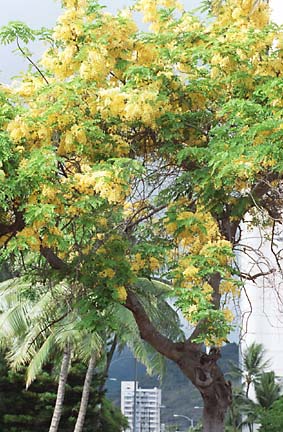


Streets are sprinkled with hues
By Lois Taylor
of summer as flowering
trees bloom
Ever Green
Star-BulletinIT'S that magic time again when our flowering trees are in full blossom. Watch for hundreds of them as you drive around town (and be grateful that somebody else has to rake up the flowers.)
The official tree of the City of Honolulu is the Wilhelmina Tenney rainbow shower, exploding now with flowers in shades from cream to yellow and peach, apricot and a rosy orange. The colors change constantly in light breezes because they differ on the inside and the outside of the petals.
The Wilhelmina Tenney is a cross between the golden shower, a native of northern India, and the pink and white shower, a native of Java and Sumatra.
Blossoms from the pink and white shower were pollinated by a blossom from the golden shower back in 1918 by David Haughes, head nurseryman for the Board of Agriculture of the Territory of Hawaii. They are now propagated by air layering or grafting on tap rooted seedlings.
They can be seen at their best at Kapiolani Park, in the parking lot of Linekona Art Center across from Thomas Square, along King Street between Punahou and McCully streets and on the the University of Hawaii at Manoa campus.
The Midas touch
The golden shower has sunshine bright flowers hanging in big clusters from slender branches. You can find them growing in Waialae Kahala and on Pensacola Street. They are used as street trees in front of the office building called 711 Kapiolani Boulevard, which is actually on Cooke Street. You can also see them from the freeway as you pass Foster Garden in the Liliha areas.The pink and white shower is a smaller tree than either the golden or rainbow varieties. It loses its leaves in the winter, and the flowers often appear in the spring before the new leaves do. Both the golden and the pink and white flower from March through August. There are little groves of pink shower trees at Kanewai Park near the Hawaiian Studies complex on Dole Street at the University of Hawaii.

The gold tree differs from the golden shower with its bell-shaped flowers and its height of up to 100 feet. But the easiest way to tell them apart is from the color of the flowers. The brilliant flowers of the gold tree are visible from miles away. If you are driving up Tantalus, you can spot gold trees in Manoa Valley by their almost luminous glow, and there is one on the slope of Makiki Heights visible from the freeway.Why do you suppose they paint fire trucks and school buses that color? Golden showers are more restrained, the shade of lemon sherbet.
The gold tree is a native of Mexico, where there aren't many left. Its wood, known as white mahogany, is prized by furniture makers for its color and strength, and is regularly harvested wherever it grows in tropical America.
A blaze of color
The royal poinciana flowers throughout spring and summer with blazing colors of scarlet and orange. A native of Madagascar, it was introduced here in 1855 by Dr. William Hillebrand. The tree grows to 40 feet, with smooth gray bark and lacy leaves that look like ferns. A row of them is flowering in front of the Admiral Thomas condominium on Victoria Street near Thomas Square, and there are several in front of the engineering building on Dole Street at the UH.The African tulip tree has flowers in the same flaming colors as the poinciana, but these fiery red flowers grow in circles around the tightly crowded buds at the tips of the branches, rather than in dense clusters all over the canopy of the tree as the poinciana does. You can most easily identify either of these by their leaves.
The poinciana has fernlike leaves and the African tulip has big shiny green leaves that grow to 2 feet long. Because of its size and its dense foliage, the African tulip provides deep shade where few other plants will grow and it isn't used as much as the poinciana. You can find African tulip trees on Mott-Smith Drive and around Waialae-Kahala and Hawaii Kai.
The lovely jacaranda trees with their deep lavender flowers are just about finished blooming now. The bell-shaped flowers cover the bare branches of the trees most abundantly for about a month in late spring. The tree is native to Brazil, and a magnificent stand of them grows at Schofield Barracks, easily visible from the highway. The trees have feathery leaves, and the flowers appear in clusters at the branch tips.
About the only flowering tree that is practical for the home garden, unless you have acres of space and a fetish for raking, is the plumeria.
You don't have to look far to find one in full bloom. They are all over the place. We tend to ignore them for that very reason, but the common plumeria is really very special. It flowers almost year round and is a constant source of lei material, it comes in a variety of colors with a lovely fragrance, and takes very little care.
So take a walk or a drive, and admire the living tapestry of Oahu's flowering trees.
Click for online
calendars and events.